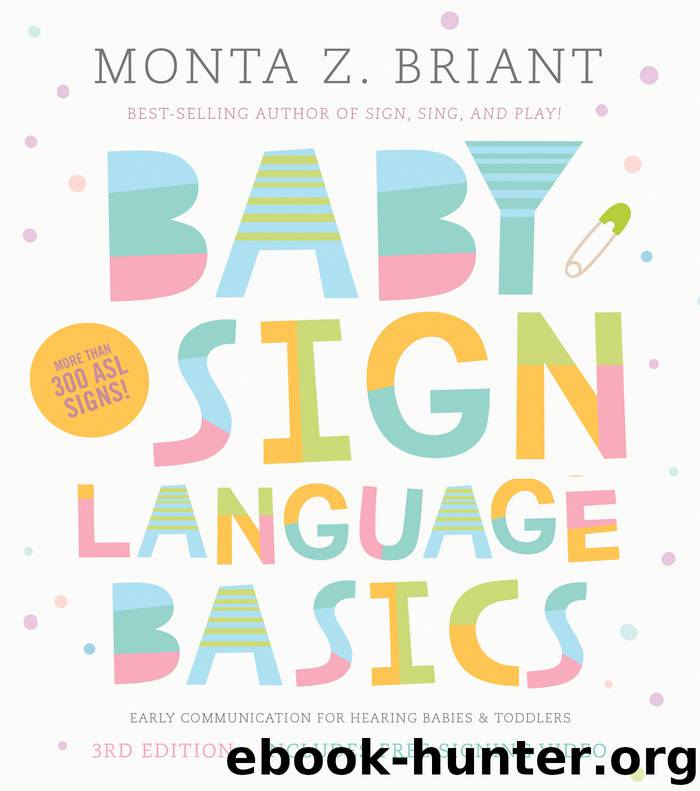Baby Sign Language Basics by Monta Z. Briant

Author:Monta Z. Briant
Language: eng
Format: epub
Publisher: Hay House
Published: 2018-05-30T16:00:00+00:00
Sirena enjoys signing a story with her cousin Ruby and Aunt Susan.
Chapter 16
Including Caregivers, Family, and Friends
Anyone who cares for or regularly interacts with your child can and should be involved in signing with him. The more you can get family members, friends, and caregivers in on it, the better your baby’s signing will come along.
Signing with Family Members
Sometimes parents run into resistance from other family members. A misinformed but well-meaning grandparent may be concerned that a signing child who can just use his hands will become “too lazy” to talk, for instance, or a spouse may mistakenly believe that signing will stigmatize the child as “slow” or disabled. Some dads may not take the idea of baby sign language seriously or may consider it as something that’s in “Mom’s department.”
It can often be difficult to get these people to read a book when they already have a negative or passive mind-set, so a really great way to win them over is to bring them to a local baby sign language class or share online videos with them of babies signing.
Even skeptical family members will most likely be won over once they see your baby actually start to sign—they won’t be able to resist having that kind of close, communicative relationship with him, too.
Signing and Siblings
Whether or not you’ve ever signed with your older child, big brothers and sisters love learning signs and teaching them to a new baby. It’s a great way for an older child to interact with the baby, who may still be too young to “play,” and babies tend to be especially fascinated by everything an older child does. Helping to teach a younger sibling to sign is an important job for a big sister or brother and is something they can be very proud of! They can sign during playtime or while Mommy’s or Daddy’s hands are full with changing, feeding, or driving the car. Preschool-age siblings can even “read” a story to the baby by signing about the pictures in a book, while elementary-age children can read aloud as they sign the words. And signing is still extremely beneficial to older children. Even after children can talk, signing continues to enhance literacy skills, improving vocabulary, spelling, and reading. So, if having a new baby in the house gets your older ones interested in signing, all the better!
Signing and Child Care
Many working parents would love to sign with their babies, but they’re concerned about how signing will fit into the childcare picture. If your little one will be spending most of his day in someone else’s care, then the other caregiver(s) should most definitely be involved in signing with him as well.
Many child-care and preschool programs are starting to include signing as an integral part of their curriculum. Early childhood educators who keep up on current research in the field of child development know that signing with the children in their care not only makes life easier and happier for the kids, but it’s also easier and happier for the staff.
Download
This site does not store any files on its server. We only index and link to content provided by other sites. Please contact the content providers to delete copyright contents if any and email us, we'll remove relevant links or contents immediately.
The Art of Coaching Workbook by Elena Aguilar(50989)
Trainspotting by Irvine Welsh(21519)
Twilight of the Idols With the Antichrist and Ecce Homo by Friedrich Nietzsche(18503)
Fangirl by Rainbow Rowell(9097)
Periodization Training for Sports by Tudor Bompa(8170)
Change Your Questions, Change Your Life by Marilee Adams(7635)
This Is How You Lose Her by Junot Diaz(6795)
Asking the Right Questions: A Guide to Critical Thinking by M. Neil Browne & Stuart M. Keeley(5641)
Grit by Angela Duckworth(5523)
Red Sparrow by Jason Matthews(5390)
Paper Towns by Green John(5091)
Room 212 by Kate Stewart(5038)
Ken Follett - World without end by Ken Follett(4645)
Housekeeping by Marilynne Robinson(4347)
The Sports Rules Book by Human Kinetics(4294)
Double Down (Diary of a Wimpy Kid Book 11) by Jeff Kinney(4207)
Papillon (English) by Henri Charrière(4198)
The Motorcycle Diaries by Ernesto Che Guevara(4012)
Exercise Technique Manual for Resistance Training by National Strength & Conditioning Association(3956)
